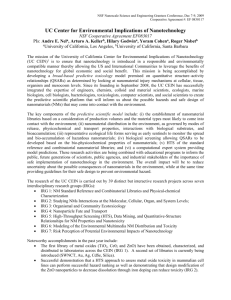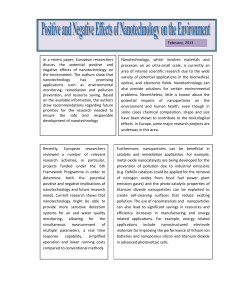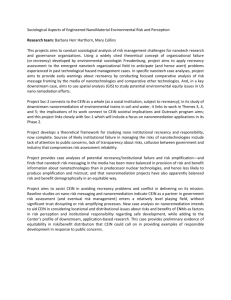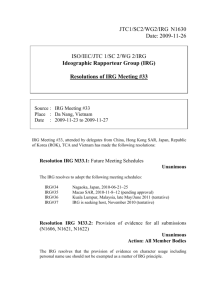UC Center for Environmental Implications of Nanotechnology 083017
advertisement
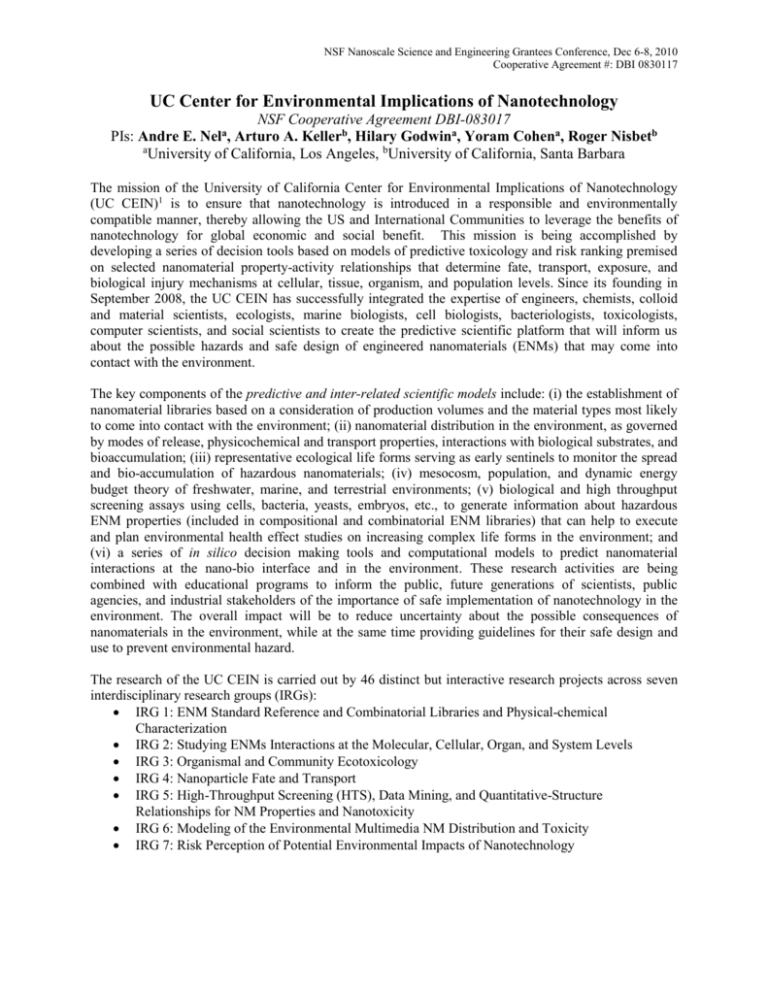
NSF Nanoscale Science and Engineering Grantees Conference, Dec 6-8, 2010 Cooperative Agreement #: DBI 0830117 UC Center for Environmental Implications of Nanotechnology NSF Cooperative Agreement DBI-083017 PIs: Andre E. Arturo A. Kellerb, Hilary Godwina, Yoram Cohena, Roger Nisbetb a University of California, Los Angeles, bUniversity of California, Santa Barbara Nela, The mission of the University of California Center for Environmental Implications of Nanotechnology (UC CEIN)1 is to ensure that nanotechnology is introduced in a responsible and environmentally compatible manner, thereby allowing the US and International Communities to leverage the benefits of nanotechnology for global economic and social benefit. This mission is being accomplished by developing a series of decision tools based on models of predictive toxicology and risk ranking premised on selected nanomaterial property-activity relationships that determine fate, transport, exposure, and biological injury mechanisms at cellular, tissue, organism, and population levels. Since its founding in September 2008, the UC CEIN has successfully integrated the expertise of engineers, chemists, colloid and material scientists, ecologists, marine biologists, cell biologists, bacteriologists, toxicologists, computer scientists, and social scientists to create the predictive scientific platform that will inform us about the possible hazards and safe design of engineered nanomaterials (ENMs) that may come into contact with the environment. The key components of the predictive and inter-related scientific models include: (i) the establishment of nanomaterial libraries based on a consideration of production volumes and the material types most likely to come into contact with the environment; (ii) nanomaterial distribution in the environment, as governed by modes of release, physicochemical and transport properties, interactions with biological substrates, and bioaccumulation; (iii) representative ecological life forms serving as early sentinels to monitor the spread and bio-accumulation of hazardous nanomaterials; (iv) mesocosm, population, and dynamic energy budget theory of freshwater, marine, and terrestrial environments; (v) biological and high throughput screening assays using cells, bacteria, yeasts, embryos, etc., to generate information about hazardous ENM properties (included in compositional and combinatorial ENM libraries) that can help to execute and plan environmental health effect studies on increasing complex life forms in the environment; and (vi) a series of in silico decision making tools and computational models to predict nanomaterial interactions at the nano-bio interface and in the environment. These research activities are being combined with educational programs to inform the public, future generations of scientists, public agencies, and industrial stakeholders of the importance of safe implementation of nanotechnology in the environment. The overall impact will be to reduce uncertainty about the possible consequences of nanomaterials in the environment, while at the same time providing guidelines for their safe design and use to prevent environmental hazard. The research of the UC CEIN is carried out by 46 distinct but interactive research projects across seven interdisciplinary research groups (IRGs): IRG 1: ENM Standard Reference and Combinatorial Libraries and Physical-chemical Characterization IRG 2: Studying ENMs Interactions at the Molecular, Cellular, Organ, and System Levels IRG 3: Organismal and Community Ecotoxicology IRG 4: Nanoparticle Fate and Transport IRG 5: High-Throughput Screening (HTS), Data Mining, and Quantitative-Structure Relationships for NM Properties and Nanotoxicity IRG 6: Modeling of the Environmental Multimedia NM Distribution and Toxicity IRG 7: Risk Perception of Potential Environmental Impacts of Nanotechnology NSF Nanoscale Science and Engineering Grantees Conference, Dec 6-8, 2010 Cooperative Agreement #: DBI 0830117 Noteworthy accomplishments in the past year include: UC CEIN has played a national leadership role in Nano EHS through participating in the PCAST review of NNI Nano EHS initiatives, playing a lead role on Nano EHS in the Nano2 initiative exploring the vision for Nanotechnology in the next 10 years, and the Principal Investigator acting as session chair for Nano EHS in the US-Russia Experts Meeting on Nanotechnology. The UC CEIN has also participated in the RC2 research efforts launched by the NIEHS with stimuluspackage funding and has helped to design round robin testing of ENM using protocols developed by the UC CEIN. The first library of metal oxides (TiO2, Ce02 and ZnO) have been obtained, characterized, and distributed to laboratories across the CEIN. A second set of libraries is currently being introduced (SWNCT, Au, Ag, CdSe, silica, clays). The current library includes 60 different types of nanoparticles, with characterization in process on an additional 25 nanoparticles. The compositional and property variations of the library materials have allowed us to obtain new information about material properties involved in toxicology and fate and transport (IRG 1). Characterization of dispersion of commercial particles in the ENM library in six different biologically relevant media (tissue culture, bacterial culture, and yeast culture). A highly efficient method of dispersing particles was identified (fetal bovine serum) and the effect of ions in the media on the dispersion was systematically investigated. This protocol is now being used in round robin testing being conducted in other national programs in addition to the CEIN (IRG 1). Development of quantitative methodology for dispersing and assessing the dispersal state of MWCNT in tissue culture medium to conduct in vitro studies that are informative about the tubes' dispersal state on toxicological outcomes in the lung (IRG 2). Successful demonstration of the oxidative stress hierarchical paradigm for nanoparticles with varying chemistries and physicochemical characteristics to delineate the dose-response relationships between particle parameters and elicitation of biological responses consistent with oxidative stress (using CeO2, TiO2, ZnO) (IRG 2). As an exercise in safe design, doping of ZnO with Fe has been found to significantly reduce ZnO NP toxicity in mammalian cells. Toxicity screening of the redesigned NPs can now be performed by rapid throughput screening that promises delivery of data that can be used by IRG 2 and 3 to determine the effect of decreased Zn shedding in bacteria, yeast, phytoplankton, zebrafish embryos, etc. (IRG 2/3). Studies using zebrafish embryos to perform high-content screening in vivo have been undertaken on a range of CEIN library materials. The in vivo results agree with the HTS results in vitro, except for silver nanoparticles. Silver nanoparticles resulted in severe toxicity in zebrafish embryos, but did not show any obvious toxic effect in the mammalian cells. Further studies will be performed in the next period to understand the mechanism of silver nanoparticle toxicity in zebrafish. We have shown that the toxicity of ZnO nanoparticles was largely due to Zn 2+ release that interferes in zebrafish hatching due to the effect on the hatching enzyme, Zhe1. By using ion doping of the ZnO nanoparticles, the Zn2+ release was significantly reduced and the zebrafish embryos were able to hatch normally (IRG 3/5). Bacterial toxicity research in IRGs 2 and 5 shows that ZnO and CeO2 inhibit growth more than TiO2, while gram positive bacteria are found to be relatively more sensitive. Toxicity for all studies were enhanced in minimal, versus complex, aqueous media (IRG 2). High throughput screening analysis of Quantum Dots (QD) using our multi-parametric assay has demonstrated that the toxicity of this material is determined by QD composition (core/shell vs core only) as well as the presence of stabilizing agents, e.g., toluene (IRG 2). Studies examining the effects of exposure to Quantum Dots (CdSe) across trophic levels show significant bioaccumulation in bacteria and biomagnification in protozoa (IRG 2/3). Testing of ZnO and TiO2 across ecosystem types showed (i) that ZnO is consistently toxic, with toxicity appearing to result from exposure to ionic Zn following ENM aggregation and Zn NSF Nanoscale Science and Engineering Grantees Conference, Dec 6-8, 2010 Cooperative Agreement #: DBI 0830117 shedding from the agglomerates, and (ii) that TiO2 nanoparticles are non-toxic, and sometimes stimulatory to biological processes and production, unless there is exposure to relatively high levels of UV light, at which point this ENM displays toxicity. Such patterns were observed in marine phytoplankton and copepod grazers, soil microbial communities, and terrestrial plants (IRG 3). Development of a TiO2 library that is Fe-doped to adjust the material bandgap with the capacity to generate electron-hole pairs and oxygen radicals under UVB and longer wavelength conditions. The feasibility of attaining cytotoxicity at longer wavelength has been proven in mammalian tissue culture studies and the application will be further tested in aquatic life forms under bright sunlight exposure conditions (IRG 2/3). Through studying the key questions with regards to the mobility, persistence, bioavailability and reactivity of NPs in actual environmental media, we have found that : (i) ZnO is likely to dissolve rapidly (within days) in most natural conditions, so that the risk is mostly due to the Zn2+ ion rather than the NPs themselves; (ii) the MeOs aggregate rapidly in seawater and other high ionic strength media, but are much more stable in freshwater and other media high in NOM and low ionic strength; (iii) the presence of NOM plays a major role in preventing attachment of the MeO NPs to mineral surfaces; (iv) filtration of the NPs in groundwater and sediments may occur if they aggregate significantly, but mostly due to straining as opposed to attachment to the porous media; (v) the mobility of the MeO NPs is greatly increased by the presence of NOM, whether in seawater, freshwater or groundwater; (vi) the photoactivity of the MeO NPs is a strong function of surface chemistry, followed by the effect of the surrounding media; (vii) the wettability of the MeO NPs controls their rate of aggregation and their interactions with organic molecules; and (viii) NP morphology plays an important role in controlling aggregation, with results so far indicating that a flat, plate-like morphology aggregates much faster than a spherical particle (IRG 4). A study on the removal of ENM from aqueous systems has shown that efficient removal can be achieved by optimal pH destabilization, coagulant dosing, sedimentation, and ultrafiltration. This has important implications for water treatment and handling of nanoparticle-laden waste streams. This study also fits in with the objective of improving ENM safety (IRG 4). Through validation of commercially available HTS technology, we have successfully implemented gene reporter assays that provide readouts of known cellular signaling pathways. Preliminary results identify genotoxicity in a subset of ENMs. The data from these studies are then integrated into IRG 6 as training data to establish methods for modeling ENM/conditions that induce stress and/or toxicity (IRG 5). A new efficient computer algorithm for feature selection ranking was developed for screening and ranking nanoparticle properties for the development of quantitative property-structure relationships. The applicability of the method was demonstrated with databases from the machine learning repository, polymeric nanoparticles insulin retention data, and TiO2 nanotoxicity (IRG 6). NP aggregation modeling is providing information on the expected size distribution of NP suspensions, under various environmental and experimental conditions, thus supplying crucial information for the design of NP experimental protocols and for assessing the relative importance of transport pathways pertinent for modeling the transport and fate of nanoparticles (IRG 6). An international Survey of nano industry EHS officers regarding NM environmental risks and perceptions has completed the data collection phase, and the results are currently being analyzed. Some key finding to date: (i)Although 87% of companies report having a general EHS program, only 45% of companies have a nano-specific EHS program; (ii) Lack of information is cited by a majority of participants as an impediment to implementation of Nano EHS Programs; and (iii) Companies employed more than 20 employees are more likely to identify "lack of information" as an impediment to implementing a nano-specific EHS program (IRG 7). NSF Nanoscale Science and Engineering Grantees Conference, Dec 6-8, 2010 Cooperative Agreement #: DBI 0830117 In Summer 2010, a web survey of 424 non S&E, nanotoxicology, and regulator experts was completed to asses views of ENM risks and regulations. The results of this study will provide a vital comparative framework for UC CEIN public and industry risk perception studies (IRG 7). A major goal of the UC CEIN is to train the next generation of nano-scale scientists, engineers, and regulators to anticipate and mitigate potential future environmental hazards associated with nanotechnology. Our educational programs are developed to broaden the knowledge base of the environmental implications of nanotechnology through academic coursework, world-class research, training courses for industrial practitioners, public outreach, and a journalist–scientist communication program. Significant progress has been made on several Education and Outreach goals that enhance our ability to have a broader impact on the scientific, educational, and policy communities both nationally and internationally. These include: i) activities that integrate across IRGs to ensure a unified and effective approach to mentoring and training both students and postdoctoral researchers; and ii) activities focusing on communicating the findings of the UC CEIN to a broader audience and varied constituencies with the goal to framing these findings to provide a scientific basis for related policy and regulatory decisions. This year, UC CEIN has expanded its use of internet-based technologies to broaden our online academic offerings. Professor Roger Nisbet taught a new graduate-level short course on Dynamic Energy Budget Theory. This course was made available online to 71 international participants, and the lectures have been archived and made publically available on iTunes U. Additionally, work is underway to translate our Nanotoxicology Capstone course into an online course that will be made available to research/education partners and will be taught to partner institutions in Mexico in collaboration with the NIH Fogarty Training Program. Our Center-wide seminar series continues to be webcast, and on October 13, 2010, UC CEIN co-sponsored (with California Department of Toxic Substances Control) and hosted Nanotechnology VI: Progress in Protection - a day-long workshop on the Environmental Health & Safety of Engineered Nanomaterials. In addition to the 100 in-person attendees, over 200 participated via webcast in the event, and the lectures are being archived and will be available on iTunes U. Finally, the UC CEIN co-sponsored (with CEINT) the Second International Conference on Environmental Implications of Nanotechnology at the UCLA Campus in May 2010. Over the course of two days, more than 200 participants from academia, industry, government, and the public were in attendance to learn about the latest advances in the environmental implications of ENMs. In the past year, our Public Outreach programs have matured under the coordination of the UC CEIN Education and Outreach coordinator. Through active partnerships with the California Science Center, Santa Monica Public Library, California NanoSystems Institute at UCLA, and the Brentwood School (K12), we have conducted a number of public and K-12 outreach events, including Nano Days 2010 demonstrations at the California Science Center and the Santa Barbara Museum of Natural History; "Nanotechnology: Small is Big" at the Santa Monica Public Library; "Nanotechnology: Small Things on a Big Planet" at the Santa Barbara Public Library; and demonstrations on nanotechnology at the UCLA Sci/Art NanoLab Summer Program, the CNSI Educators Program, and "Explore Your Universe" public education event at UCLA. Finally, from a policy perspective, the UC CEIN Education program has partnered with the California Department of Toxic Substances Control to provide a evaluation of the recent mandatory statewide call-in for carbon nanotubes and in partnership with the California Nano EH&S working group, we are developing and planning to test guidance for the safe handling of ENMs in academic settings. We are currently organizing our Education and Outreach activities for the next year. As part of our trainee mentoring activities, we are coordinating a day long workshop with Sharon Dunwoody of the NSF Nanoscale Science and Engineering Grantees Conference, Dec 6-8, 2010 Cooperative Agreement #: DBI 0830117 University of Wisconsin entitled "Communicating Your Science to the Public," and will be holding our annual Student/Postdoctoral Scholars leadership skills workshop on March of 2010. Finally, we are again co-sponsoring (with CEINT) the 2011 International Conference on Environmental Implications of Nanotechnology, which will be held on May 9-10, 2011 at Duke University in North Carolina. Select Publications - 2010 Saji George, Suman Pokhrel, Tian Xia, Benjamin Gilbert, Zhaoxia Ji, Marco Schowalter, Andreas Rosenauer, Robert Damiseaux, Kenneth A. Bradley, Lutz Maedler, Andre E. Nel. Use of a Rapid Cytotoxicity Screening Approach to Engineer a Safer Zinc Oxide Nanoparticle through Iron Doping. ACS Nano, 2010, 4 (1), 15-29. DOI:10.1021/nn901503q. Zhaoxia Ji, Xue Jin, Saji George, Tian Xia, Huan meng, Xiang Wang, Elizabeth Suarez, Haiyuan Zhang, Eric MV Hoek, Hilary Godwin, Andre E. Nel, and Jeffrey I. Zink. Dispersion and Stability of TiO2 Nanoparticles in Cell Culture Media. Environmental Science & Technology, 2010, 44(19) 7309-7314. DOI: 10.1021/es100417s. Keller, A., X. Wang, D. Zhou, H. Lenihan, G. Cherr, B. Cardinale, RJ Miller, Stability and aggregation of metal oxide nanoparticles in natural aqueous matrices. Environmental Science and Technology, 2010, 44(6), 1962-1967. DOI: 10.1021/es902987d. Kovochich, M., Espinasse, B., Auffan, M., Hotze, E. M., Wessel, L., Xia, T., Nel, A.E., Wiesner, M.R. Comparative toxicity of C60 aggregates towards mammalian cells: role of the tetrahydrofuran (THF) decomposition. Environmental Science and Technology. 43(16), 6378-6384. 2009, doi:10.1012/es900990d López-Moreno, M.L., de la Rosa, G., Hernández-Viezcas, J.A., Castillo-Michel, H. Peralta-Videa, J.R., Gardea-Torresdey, J.L. 2010. Evidence of the differential biotransformation and genotoxicity of ZnO and CeO2 nanoparticles on soybean (Glycine max) plants. Environmental Science and Technology 2010, 44(19) 7315-7320. doi: 10.1021/es9038919. López-Moreno, M.L., de la Rosa, G., Hernández-Viezcas, J.A, Peralta-Videa, J.R., Gardea-Torresdey, J.L. XAS corroboration of the uptake and storage of CeO2 nanoparticles and assessment of their differential toxicity in four edible plant species. Journal of Agricultural and Food Chemistry 2010, 58 (6), 3689-3693. doi: 10.1021/jf904472e. Huan Meng, Tian Xia, Saji George, Andre E. Nel, The Use of a Predictive Toxicological Paradigm for the Safety Assesment of Nanomaterials. ACS Nano (Perspective). 2009, 3 (7), pp 1620 –1627. doi:10.1021/nn9005973 Robert J. Miller, Hunter S. Lenihan, Erik B. Muller, Nancy Tseng, Shannon K. Hanna, and Arturo A. Keller, Impacts of metal oxide nanoparticles on marine phytoplankton. Environmental Science & Technology. 2010, 44(19) 7329-7334. DOI: 10.1021/es100247x. Muller, E.B. Nisbet, R.M. and Berkley, H. Sublethal toxicant effects with dynamic energy budget theory: model formulation. Ecotoxicology, 2010, 19(1), 48 – 60. DOI: 10.1007/s10646-009-0385-3 Satterfield, T., Kandlikar, M., Beaudrie, C, Conti, J., Harthorn,B., Anticipating the Perceived Risk of Nanotechnologies. Nature Nanotechnology 4, pp.752-758. 2009, doi:10.1038/nnano.2009.265 NSF Nanoscale Science and Engineering Grantees Conference, Dec 6-8, 2010 Cooperative Agreement #: DBI 0830117 T. Xia, H. Meng, S. George, H Zhang, X. Wang, Z. Ji, J.I. Zink, A.E. Nel. Strategy for toxicity screening of nanomaterials (Mini review). Material Matters (Sigma), 2010, 5(3) 82-84. Yichi Zhang, Yifeng Shi, Ya-Hsuan Liou, April M. Sawvel, Xiaohong Sun, Yue Cai, Patricia A. Holden, Galen D. Stucky. “High Performance Separation of Aerosol Sprayed Mesoporous TiO2 Sub Microspheres from Aggregates via Density Gradient Centrifugation”, Journal of Materials Chemistry , 2010, 20, 4162-4167. DOI: 10.1039/b926183d. Zhou, D., Keller, A., Role of morphology in the aggregation kinetics of ZnO nanoparticles. Water Research, 2010, 44(9), 2948 - 2956. DOI: 10.1021/es902987d. References 1 For additional information about the Center, its projects, and a full list of publications, please visit http://www.cein.ucla.edu. 2 The UC CEIN is headquartered at UC Los Angeles in partnership with UC Santa Barbara, UC Davis, UC Riverside, Columbia University, University of Texas El Paso, University of New Mexico/Sandia National Laboratory, Nanyang Technological University (Singapore), the Molecular Foundry at Lawrence Berkeley National Laboratory, Lawrence Livermore National Laboratory, , the University of Bremen (Germany), University of British Colombia (Canada), Cardiff University (Wales), University College Dublin (Ireland), and the Universitat Rovira i Virgili (Spain).
